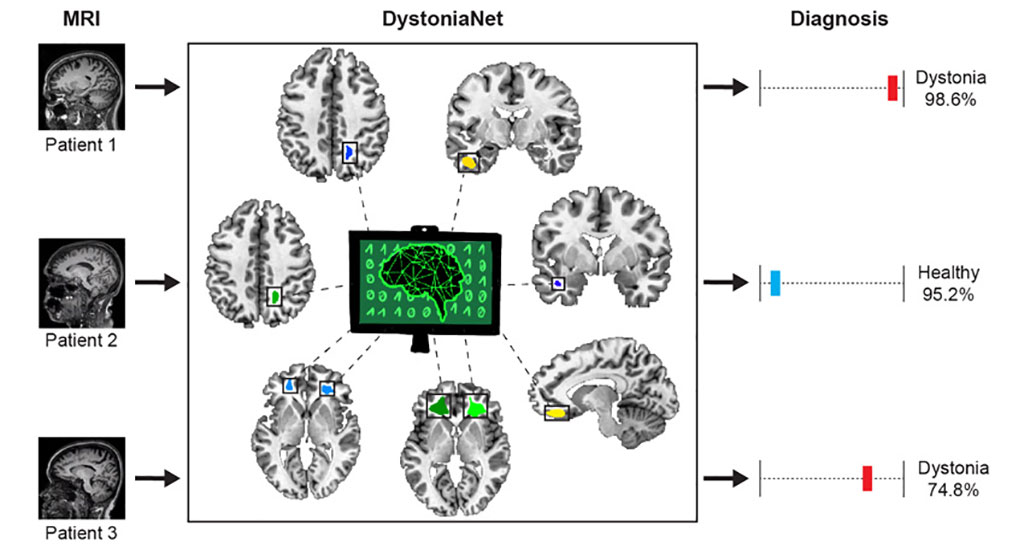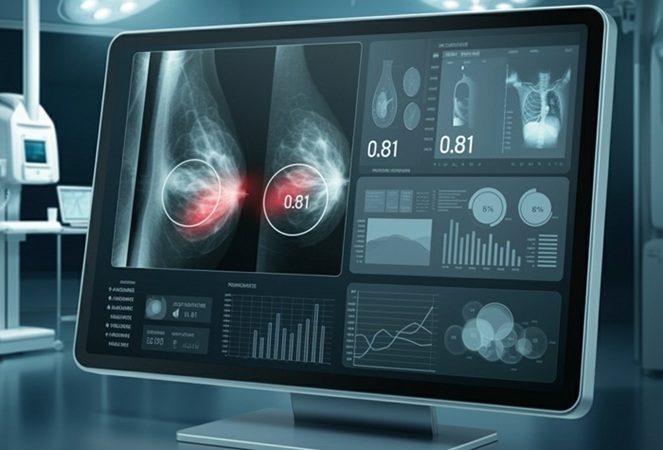Combined MRI and AI Can Identify Focal Dystonia Instantly
|
By MedImaging International staff writers Posted on 13 Oct 2020 |

Image: Comparison of the MRI scans processed by DystoniaNet (Photo courtesy of MEEI)
The conjunction of magnetic resonance imaging (MRI) and artificial intelligence (AI) can identify patients with dystonia in under a second, according to a new study.
The new platform, called DystoniaNet, developed at the Massachusetts Eye and Ear Infirmary (MEEI; Boston, USA), can identify a microstructural neural network biomarker that allows objective and accurate diagnosis of isolated dystonia, based on the disorder pathophysiology and MRI structural brain images. The algorithm was developed using the MRI’s of 612 subjects, including 392 with three forms of isolated focal dystonia (laryngeal dystonia, cervical dystonia, and blepharospasm), and those of 220 healthy controls.
DystoniaNet successfully identified clusters in the corpus callosum, the anterior and posterior thalamic radiations, the inferior fronto-occipital fasciculus, and inferior temporal and superior orbital gyri as the biomarker components, regions that are known to contribute to abnormal interhemispheric information transfer, heteromodal sensorimotor processing, and executive control of motor commands. In all, the DystoniaNet AI biomarker showed an accuracy of 98.8% in diagnosing dystonia, with a referral of 3.5% of cases due to diagnostic uncertainty.
DystoniaNet also outperformed shallow machine-learning algorithms, showing nearly a 20% increase in benchmark diagnostic performance. Importantly, the microstructural neural network biomarker and its DystoniaNet platform showed substantial improvement over the current 34% agreement on dystonia diagnosis between clinicians. In addition, the diagnostic decision by DystoniaNet was computed in just 0.36 seconds. The study was published on October 1, 2020, in PNAS.
“We basically leveraged the advances made in deep learning and designed an architecture that was able to look at raw structural MRI and find a biomarker for dystonia that could help with the diagnosis of this disorder,” said study author Davide Valeriani, PhD. “We specifically took an approach that could be easily clinically translated, which is why we used raw structural MRI. Given the platform's performance and the average length of time to diagnosis, it has potential to beneficial impact the movement disorder field.”
Dystonia is a neurological disorder of heterogeneous pathophysiology, which causes involuntary muscle contractions leading to abnormal movements and postures. Its diagnosis is remarkably challenging due to the absence of a biomarker or gold standard diagnostic test. This leads to a low agreement between clinicians, with up to 50% of cases being misdiagnosed and diagnostic delays extending up to 10 years.
Related Links:
Massachusetts Eye and Ear Infirmary
The new platform, called DystoniaNet, developed at the Massachusetts Eye and Ear Infirmary (MEEI; Boston, USA), can identify a microstructural neural network biomarker that allows objective and accurate diagnosis of isolated dystonia, based on the disorder pathophysiology and MRI structural brain images. The algorithm was developed using the MRI’s of 612 subjects, including 392 with three forms of isolated focal dystonia (laryngeal dystonia, cervical dystonia, and blepharospasm), and those of 220 healthy controls.
DystoniaNet successfully identified clusters in the corpus callosum, the anterior and posterior thalamic radiations, the inferior fronto-occipital fasciculus, and inferior temporal and superior orbital gyri as the biomarker components, regions that are known to contribute to abnormal interhemispheric information transfer, heteromodal sensorimotor processing, and executive control of motor commands. In all, the DystoniaNet AI biomarker showed an accuracy of 98.8% in diagnosing dystonia, with a referral of 3.5% of cases due to diagnostic uncertainty.
DystoniaNet also outperformed shallow machine-learning algorithms, showing nearly a 20% increase in benchmark diagnostic performance. Importantly, the microstructural neural network biomarker and its DystoniaNet platform showed substantial improvement over the current 34% agreement on dystonia diagnosis between clinicians. In addition, the diagnostic decision by DystoniaNet was computed in just 0.36 seconds. The study was published on October 1, 2020, in PNAS.
“We basically leveraged the advances made in deep learning and designed an architecture that was able to look at raw structural MRI and find a biomarker for dystonia that could help with the diagnosis of this disorder,” said study author Davide Valeriani, PhD. “We specifically took an approach that could be easily clinically translated, which is why we used raw structural MRI. Given the platform's performance and the average length of time to diagnosis, it has potential to beneficial impact the movement disorder field.”
Dystonia is a neurological disorder of heterogeneous pathophysiology, which causes involuntary muscle contractions leading to abnormal movements and postures. Its diagnosis is remarkably challenging due to the absence of a biomarker or gold standard diagnostic test. This leads to a low agreement between clinicians, with up to 50% of cases being misdiagnosed and diagnostic delays extending up to 10 years.
Related Links:
Massachusetts Eye and Ear Infirmary
Latest MRI News
- AI-Assisted Model Enhances MRI Heart Scans
- AI Model Outperforms Doctors at Identifying Patients Most At-Risk of Cardiac Arrest
- New MRI Technique Reveals Hidden Heart Issues
- Shorter MRI Exam Effectively Detects Cancer in Dense Breasts
- MRI to Replace Painful Spinal Tap for Faster MS Diagnosis
- MRI Scans Can Identify Cardiovascular Disease Ten Years in Advance
- Simple Brain Scan Diagnoses Parkinson's Disease Years Before It Becomes Untreatable
- Cutting-Edge MRI Technology to Revolutionize Diagnosis of Common Heart Problem
- New MRI Technique Reveals True Heart Age to Prevent Attacks and Strokes
- AI Tool Predicts Relapse of Pediatric Brain Cancer from Brain MRI Scans
- AI Tool Tracks Effectiveness of Multiple Sclerosis Treatments Using Brain MRI Scans
- Ultra-Powerful MRI Scans Enable Life-Changing Surgery in Treatment-Resistant Epileptic Patients
- AI-Powered MRI Technology Improves Parkinson’s Diagnoses
- Biparametric MRI Combined with AI Enhances Detection of Clinically Significant Prostate Cancer
- First-Of-Its-Kind AI-Driven Brain Imaging Platform to Better Guide Stroke Treatment Options
- New Model Improves Comparison of MRIs Taken at Different Institutions
Channels
Radiography
view channel
AI Algorithm Uses Mammograms to Accurately Predict Cardiovascular Risk in Women
Cardiovascular disease remains the leading cause of death in women worldwide, responsible for about nine million deaths annually. Despite this burden, symptoms and risk factors are often under-recognized... Read more
AI Hybrid Strategy Improves Mammogram Interpretation
Breast cancer screening programs rely heavily on radiologists interpreting mammograms, a process that is time-intensive and subject to errors. While artificial intelligence (AI) models have shown strong... Read moreUltrasound
view channel
Disposable Ultrasound Patch Performs Better Than Existing Devices
Wearable ultrasound devices are widely used in diagnostics, rehabilitation monitoring, and telemedicine, yet most existing models rely on lead-based piezoelectric ceramics that pose health and environmental risks.... Read more
Non-Invasive Ultrasound-Based Tool Accurately Detects Infant Meningitis
Meningitis, an inflammation of the membranes surrounding the brain and spinal cord, can be fatal in infants if not diagnosed and treated early. Even when treated, it may leave lasting damage, such as cognitive... Read moreNuclear Medicine
view channel
PET Tracer Enables Same-Day Imaging of Triple-Negative Breast and Urothelial Cancers
Triple-negative breast cancer (TNBC) and urothelial bladder carcinoma (UBC) are aggressive cancers often diagnosed at advanced stages, leaving limited time for effective treatment decisions.... Read more
New Camera Sees Inside Human Body for Enhanced Scanning and Diagnosis
Nuclear medicine scans like single-photon emission computed tomography (SPECT) allow doctors to observe heart function, track blood flow, and detect hidden diseases. However, current detectors are either... Read more
Novel Bacteria-Specific PET Imaging Approach Detects Hard-To-Diagnose Lung Infections
Mycobacteroides abscessus is a rapidly growing mycobacteria that primarily affects immunocompromised patients and those with underlying lung diseases, such as cystic fibrosis or chronic obstructive pulmonary... Read moreGeneral/Advanced Imaging
view channel
New Ultrasmall, Light-Sensitive Nanoparticles Could Serve as Contrast Agents
Medical imaging technologies face ongoing challenges in capturing accurate, detailed views of internal processes, especially in conditions like cancer, where tracking disease development and treatment... Read more
AI Algorithm Accurately Predicts Pancreatic Cancer Metastasis Using Routine CT Images
In pancreatic cancer, detecting whether the disease has spread to other organs is critical for determining whether surgery is appropriate. If metastasis is present, surgery is not recommended, yet current... Read moreImaging IT
view channel
New Google Cloud Medical Imaging Suite Makes Imaging Healthcare Data More Accessible
Medical imaging is a critical tool used to diagnose patients, and there are billions of medical images scanned globally each year. Imaging data accounts for about 90% of all healthcare data1 and, until... Read more
Global AI in Medical Diagnostics Market to Be Driven by Demand for Image Recognition in Radiology
The global artificial intelligence (AI) in medical diagnostics market is expanding with early disease detection being one of its key applications and image recognition becoming a compelling consumer proposition... Read moreIndustry News
view channel
GE HealthCare and NVIDIA Collaboration to Reimagine Diagnostic Imaging
GE HealthCare (Chicago, IL, USA) has entered into a collaboration with NVIDIA (Santa Clara, CA, USA), expanding the existing relationship between the two companies to focus on pioneering innovation in... Read more
Patient-Specific 3D-Printed Phantoms Transform CT Imaging
New research has highlighted how anatomically precise, patient-specific 3D-printed phantoms are proving to be scalable, cost-effective, and efficient tools in the development of new CT scan algorithms... Read more
Siemens and Sectra Collaborate on Enhancing Radiology Workflows
Siemens Healthineers (Forchheim, Germany) and Sectra (Linköping, Sweden) have entered into a collaboration aimed at enhancing radiologists' diagnostic capabilities and, in turn, improving patient care... Read more




















